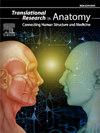Prevalence of the absence of palmaris longus muscle tendon in the population of the eastern province of Saudi Arabia
Q3 Medicine
引用次数: 0
Abstract
Background
Palmaris longus (PL) muscle is one of the most variable muscles in the human body. Racial differences in its variation are well known. This study was conducted to determine the prevalence of absence of the PL and its association with gender and side in the population of eastern province, Kingdom of Saudi Arabia.
Methods
The presence of PL was clinically determined in 200 Saudi subjects using Schaeffer's test. Three other tests (Thompson, Pushpakumar and Mishra tests) were performed to confirm the result in subjects with an absent PL.
Results
The overall prevalence of absence of PL in the eastern province population of the Saudi Arabia was 24 %. The prevalence of right, left, and bilateral absence of the PL were: 2 %, 4.5 %, and 17.5 %, respectively. There was no significant difference in PL absence with regard to the gender and side.
Conclusions
The prevalence of PL absence in the eastern province population of the Saudi Arabia represents more or less similar patterns reported in Arab and Pan Arab populations, but it was higher than those reported from East and West Asian populations as evident from our extensive literature review.
掌长肌肌腱缺失的患病率在沙特阿拉伯东部省份的人口
掌长肌(PL)是人体最易变化的肌肉之一。其变异的种族差异是众所周知的。本研究旨在确定沙特阿拉伯王国东部省份人口中PL缺失的患病率及其与性别和侧面的关系。方法采用Schaeffer试验对200例沙特患者进行临床检测。另外三种测试(Thompson, Pushpakumar和Mishra测试)证实了PL缺失受试者的结果。结果沙特阿拉伯东部省份人口中PL缺失的总体患病率为24%。正确的患病率(左)和两国缺乏PL是:2%,4.5%,和17.5%,分别。在PL缺失方面,性别和侧面没有显著差异。结论沙特阿拉伯东部省份人群中PL缺失的流行程度或多或少与阿拉伯和泛阿拉伯人群中报道的相似,但从我们广泛的文献综述中可以看出,它高于东亚和西亚人群。
本文章由计算机程序翻译,如有差异,请以英文原文为准。
求助全文
约1分钟内获得全文
求助全文
来源期刊

Translational Research in Anatomy
Medicine-Anatomy
CiteScore
2.90
自引率
0.00%
发文量
71
审稿时长
25 days
期刊介绍:
Translational Research in Anatomy is an international peer-reviewed and open access journal that publishes high-quality original papers. Focusing on translational research, the journal aims to disseminate the knowledge that is gained in the basic science of anatomy and to apply it to the diagnosis and treatment of human pathology in order to improve individual patient well-being. Topics published in Translational Research in Anatomy include anatomy in all of its aspects, especially those that have application to other scientific disciplines including the health sciences: • gross anatomy • neuroanatomy • histology • immunohistochemistry • comparative anatomy • embryology • molecular biology • microscopic anatomy • forensics • imaging/radiology • medical education Priority will be given to studies that clearly articulate their relevance to the broader aspects of anatomy and how they can impact patient care.Strengthening the ties between morphological research and medicine will foster collaboration between anatomists and physicians. Therefore, Translational Research in Anatomy will serve as a platform for communication and understanding between the disciplines of anatomy and medicine and will aid in the dissemination of anatomical research. The journal accepts the following article types: 1. Review articles 2. Original research papers 3. New state-of-the-art methods of research in the field of anatomy including imaging, dissection methods, medical devices and quantitation 4. Education papers (teaching technologies/methods in medical education in anatomy) 5. Commentaries 6. Letters to the Editor 7. Selected conference papers 8. Case Reports
 求助内容:
求助内容: 应助结果提醒方式:
应助结果提醒方式:


